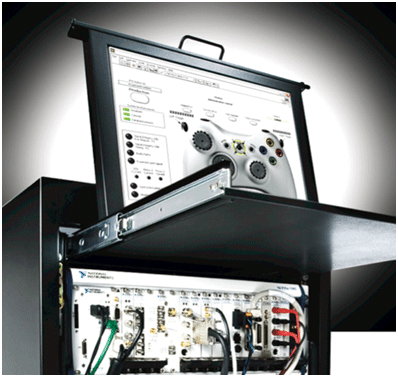 The growth in sales of Internet-of-Things (IoT) products is expected to be record breaking for the next few years, as homes, offices, stadiums, and even cars—in short, any place where people gather—can benefit from having “things” communicating their data to “the cloud” by way of the Internet. For most of these IoT devices, that means of communications will be via either licensed or unlicensed wireless access.
The growth in sales of Internet-of-Things (IoT) products is expected to be record breaking for the next few years, as homes, offices, stadiums, and even cars—in short, any place where people gather—can benefit from having “things” communicating their data to “the cloud” by way of the Internet. For most of these IoT devices, that means of communications will be via either licensed or unlicensed wireless access.
An interconnected wireless world with myriad multifunctional sensors and processing devices is already a reality. A common modern environment isn’t complete without its own ecosystem of smartphones, tablets, cameras, RF identification tags, wearable devices, and sensors—all connected through several public and private wireless standards. The wireless technologies enabling the Internet of Things (IoT) and Machine-to-Machine (M2M) devices have customized requirements and performance criteria for each application. In turn, devices based on these wireless technologies must be characterized, compliance-tested, and checked for quality before reaching an end-user. This level of testing requires highly flexible and customizable test systems that can facilitate automation and cost-effective upgrades.
A number of leading instrument makers, including Tektronix, National Instruments, Keysight Technologies and Anritsu have already addressed some of the challenges connected with characterizing IoT devices. Because of the massive scale of production for some IoT products, the test approaches are being compared to those used for cellular telephones, where shaving pennies from the cost of testing each product can be significant.
The IoT is reaching the test and measurement industry at an interesting time. Let us talk with some leading players about how IoT impacts test and measurement industry and what are the challenges..
Raviteja Chivukula,Technical Marketing Engineer at National Instruments India

Smart devices are an essential part of the IoT revolution. The number of devices, their versatility in IO, built in intelligence and diversity is ever increasing. Such smart devices entail that the test and measurement systems also become smarter, faster and flexible. Traditional approach to automated test & measurements may not be adequate for IoT devices. The limitations or challenges faced by traditional test & measurement setups can be summarized as follows:
- Scale of IoT – IoT nodes and devices are getting feature rich and being mass deployed. To cope up with this production volume, the test systems need to offer next generation measurement speeds.
- Diversity in IoT nodes – The IoT nodes, given the scale and scope, can encompass a diverse range of signals, sensors, actuators, communication protocols, processing technologies etc. To test these diverse functionalities, a measurement platform with versatile options ranging over, analog, digital, protocol, control, RF I/O is the only feasible solution.
- ‘The Unknown of IoT’ – The IoT devices and nodes are evolving over time. The communication protocols that enable effective information transfer, identification & control are still in very nascent stages. The applications and the scope is not a thoroughly charted territory. In this context, a test solution that is scalable and future-proof is essential. Instead of designing a unique test system for each unique DUT, test leaders must design a smart test system that can adapt to and test all smart devices
- Connected-ness of IoT nodes – The power of an IoT network is realized to its fullest extent by connectedness and collective intelligence sharing. For example, consider a scenario of connected Traffic light controllers which optimize the flow of traffic based on real time video inputs from various junctions in a city. Such a system is effective only if collectively optimal decisions are made by the network of the connected traffic light IoT controllers. To test such an IoT network, it is not enough to test just a single node in isolation. A closely networked, synchronized and massively scalable test platform that tests multiple of these nodes simultaneously is essential.
- Compactness & embeddedness of the IoT nodes – IoT nodes are tending to become more compact, enclosed, wireless and self-sustaining (in terms of energy scavenging) over time. The way that these nodes are being packaged is becoming increasingly ‘portless’. That is, the traditional means to do functional tests, by tapping in signals through ports is becoming increasingly difficult. This calls for a test system that can emulate a real IoT controller node and implement functional test in the form closest to the node’s actual use scenario.
NI IoT solutions
In order to meet challenges of scalability, flexibility, and adaptability NI takes a platform based approach to measurements. This platform comprises of industry standard, modular PXI measurement hardware, LabVIEW software for customizing the measurement & test system, TestStand software for test sequence automation. The functionality of the system is defined using high level graphical system design software, LabVIEW. The high level programming language, along with various toolkits and an automated test management software, help the engineers to simplify the process of test system development. A platform also allows a test system designer to build the application by leveraging the benefits of the hardware & software ecosystem.
National Instruments test platform allows for system architects to configure T&M systems by choosing from a plethora of modular instruments, analog or digital IO, communication buses, and control modules. This approach of ‘Versatile hardware + Customizable software’ solves the challenges mentioned above, like diversity and the evolving nature of IoT nodes. The hardware platform based on PXI standard, owing to its high bus throughputs, results in multifold improvement in test times giving the much needed speed required for large scale IoT node production. National Instruments PXI instrument portfolio also provides a range of FPGA based instruments to choose from. These instruments have a customizable FPGA on board that can be programmed to emulate the real world conditions of an IoT node, that is essential for ‘portless’ device testing. The NI PXI platform incorporates modules that enable the test engineers to expand the T&M system even beyond 100 PXI systems (each containing more than 10 instruments!). This can prove to be an essential feature to test & validate IoT nodes in a connected scenario.
Madhukar Tripathi, Regional Manager, Anritsu India Pvt. Ltd.

The IoT has been around for last few years and now it is rapidly growing. Life and society will change in significant manner with IoT.
IoT supporting devices & modules are growing rapidly every day. As a result there will be more testing challenges
T&M Industry is ready to face challenges in IoT domain. IoT consist of many communication modules, gadget to connect with each other, talking each other and transfering data. These are tested using various communication testing tools be it WiFi based or WiMax based or Bluetooth based device.
Test scenario in IoT is really challenging and not stable. It is difficult to replicate the environment required for IoT testing and demands too much of effort. The subsystems, sub-components, and services that are interrelated are possessed by various groups and third party units. If user is unable to access a single dependent sub-component, it could affect the testing of the whole system. There are issues related to connectivity, compatibility due to many vendors working on modules.
Anritsu Universal Wireless Test MT8870A is used for testing various communication module used in IoT domain. Anritsu Bluetooth Tester provides Bluetooth test for IoT modules.
Stephen Hire, APAC Sales Director, Cobham Wireless

The IoT is being billed as the ‘Fourth Industrial Revolution’ and will herald a truly mobile connected society, enabling a huge range of use cases for personal, industrial and business applications. This will include connected lifestyle and healthcare applications such as wearable technology, smart energy, public infrastructure, greater efficiency in manufacturing processes, and connected cars for both safety and driver convenience.
The IoT is not defined by a single standard or technology. 2G/EGPRS,Weightless-N, and proprietary low-power radio technologies and protocols are already being used for Machine-to-Machine (M2M) communications, and the market has been accelerating. One of the largest growth areas for IoT prior to the launch of 5G is expected to be in LTE. 3GPP has introduced the low-power LTE Cat-0 standard with Release 12, and this, along with the new LTE-M standard being launched within Release 13, will enable lower-cost, lower-power M2M devices to work within the currently available cellular networks. Two other IoT standards – EC-GSM (Enhanced Coverage GSM) and NB-IoT – are also being introduced at Release 13.
For the manufacturing test of these low-complexity, non-speech devices the main challenge will be to reduce the cost of test and maximise throughput, while ensuring that any critical performance parameters are still being accurately validated.
Likewise for cellular networks that are being expanded to include IoT, the effects of loading the network with millions of these devices will need to be validated.
We offer Flexible, multi-standard, multi-device test systems based on the PXI modular instrumentation platform, along with PXI Maestro, are ideal for the manufacturing test of low complexity IoT terminals.
At a network level, the availability of network validation tools that emulate realistic data usage scenarios has been vital to the development and rollout of LTE. Including the characteristics of the predicted volume of IoT devices as part of the traffic models is an important factor in ensuring continued quality of service and quality of user experience as next generation networks develop. The latest generation of the TM500 network test system has the capability to emulate tens of thousands of M2M/MTC devices, to evaluate the effect on the network of connecting large numbers of these low-power, low-complexity devices. This helps network operators and infrastructure vendors to validate 4G cellular network performance in preparation for deploying IoT connectivity.






